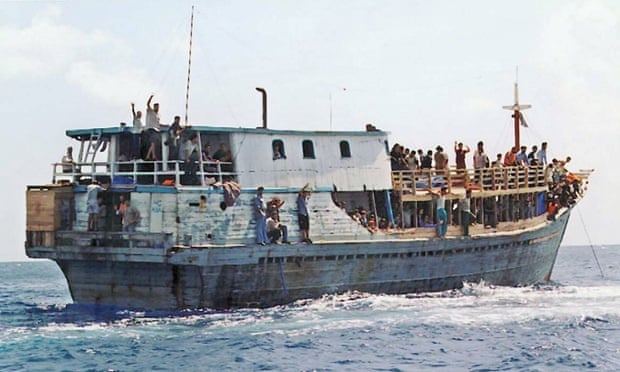Scott Morrison may gloat but asylum seekers' boats haven't really stopped
Sunili Govinnage
Two facts emerge as the UNHCR meets in Geneva to look at protection for refugees at sea: more people than ever are fleeing their country by boat, and deterrence doesn’t stop them

‘The UNHCR estimates that around 21,000 people have departed from the Bangladesh-Burmese maritime border in the two months of October and November 2014.’ Photograph: AAP
Thursday 11 December 2014 09.30 AEST
For all the slogans and military operations, over 54,000 people have boarded boats across the Indian Ocean this year, with around 20,000 in just the two months of October and November. As much as
Scott Morrisonmay gloat, the boats haven’t really stopped.
The point you won’t see on any media release or hear at a doorstop press conference is this: even if people haven’t drowned on the way to Australia, they’ve still drowned. Because people fleeing countries in the region are still getting on boats.
There are many inconvenient facts for those who won’t stop talking about stopping the boats. But perhaps the facts are not so bothersome if they aren’t on the nightly news. After all, if an asylum seeker drowns well enough away from Australian territorial waters, will there be a leadership challenge today? And have you seen Julie Bishop’s broach?
For the rest of us, here are some details.
According to the UNHCR report on
Irregular Maritime Movements in South-East Asia, over 50,000 people set sail just from the Bay of Bengal area in January-November 2014. The smugglers operating in the region move people who are
trafficked as well as those
paying for passage outside of legal migration channels. The latter includes people such as ethnic
Rohingya who do not have any nationality (and therefore no official travel documentation) and have a long history of
persecution and discrimination by the Burmese government.
The UNHCR estimates that around 21,000 people have departed from the Bangladesh-Burmese maritime border in the two months of October and November 2014. About 10% were women, and around one-third of arrivals interviewed by UNHCR in Thailand and Malaysia were minors. The numbers for October 2014 are a marked increase (37%) from the year before.
And not all the deaths at sea are merely from drowning, according to the report:
“One in every three interviewees said at least one other passenger on their boat died en route; one in every 10 said 10 or more people died on board. Deaths were attributed to severe beatings by the crew, lack of food and water, illness, and heat.”
Globally, around
350,000 people have risked it all by taking a boat this year. On 10-11 December 2014, UNHCR is hosting a meeting looking specifically at
protection at sea. The non-governmental organisations taking part have
recommended, among other things, that to implement effective protection and ensure safety at sea, it is vital to “address ‘route causes’ and ‘root causes’ of forced and dangerous migration”.
UNHCR notes that these
reasons for irregular movement include: conflict and war, protracted refugee situations, statelessness, the absence or inadequacy of protection systems, family separation, poverty and economic inequality.
What is notably absent from all the recommendations to “stop the boats” from these experts is deterrence, which in
Morrison’s parlance is also known as “taking the sugar off the table”. This was of course the honourable minister’s reasoning last month for reducing the number of refugees Australia would resettle from Indonesia and banning those who registered with UNHCR in Indonesia after 1 July 2014 from ever getting to Australia.
Sweet though that poison may be (and poisonous is certainly how one can characterise the way Australia treats those who come across the sea), no refugee is paying a people smuggler for any sort of benefit other than getting the hell out of the hell they were in.
At the opening of the UNHCR meeting yesterday, the High Commissioner for
Refugees António Guterres said, “You can’t stop a person who is fleeing for their life by deterrence, without escalating the dangers even more”.
So what would work to actually stop people getting on boats? Again, according to the NGO recommendations, practical solutions for preventing irregular migration by sea include:
- More opportunities for legal migration
- Cooperative international agreements by states to provide more safe-havens for asylum seekers, e.g., through expanded UNHCR resettlement programmes; and
- Migration and asylum policies that recognise the benefits of migration and the contributions of migrants and refugees to the development of countries of destination and origin.
It’s ultimately pretty simple and obvious: the key to reducing irregular movement of people by dangerous ways is to increase pathways for properly managed, safe and regulated movement. It involves as Guterres said, “looking at why people are fleeing, what prevents them from seeking asylum by safer means”.
In practice, nobody is going to be able to neatly pack their passport and customs declarations cards in order to flee discrimination or state persecution in a “regular” way. Which is why, in the case of those people, the Refugees Convention set up a system for countries around the world to join forces to help them, and why the UNHCR’s resettlement process allows for countries to accept refugees who cannot return to where they fled. Both of which the Australian government is slowly but surely repudiating.
Opening and expanding legal channels for migration and the movement of asylum seekers and refugees will reduce the use of smugglers and black-market operations. But for various reasons it’s doubtful Australia would be checking off anything on that list of solutions any time soon.
And so the boats will sail on, but just a little further off Morrison’s horizon.

